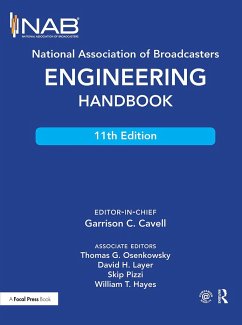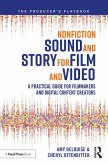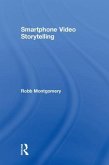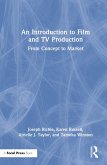National Association of Broadcasters Engineering Handbook
Herausgeber: Cavell, Garrison
National Association of Broadcasters Engineering Handbook
Herausgeber: Cavell, Garrison
- Gebundenes Buch
- Merkliste
- Auf die Merkliste
- Bewerten Bewerten
- Teilen
- Produkt teilen
- Produkterinnerung
- Produkterinnerung
The NAB Engineering Handbook is the definitive resource for broadcast engineers. It provides in-depth information about each aspect of the broadcast chain from audio and video contribution through an entire broadcast facility all the way to the antenna.
Andere Kunden interessierten sich auch für
![Finding Your Career in the Modern Audio Industry Finding Your Career in the Modern Audio Industry]() April TuckerFinding Your Career in the Modern Audio Industry183,99 €
April TuckerFinding Your Career in the Modern Audio Industry183,99 €![Radio Audiences and Participation in the Age of Network Society Radio Audiences and Participation in the Age of Network Society]() Radio Audiences and Participation in the Age of Network Society204,99 €
Radio Audiences and Participation in the Age of Network Society204,99 €![Music Documentaries for Radio Music Documentaries for Radio]() Sam ColeyMusic Documentaries for Radio183,99 €
Sam ColeyMusic Documentaries for Radio183,99 €![Nonfiction Sound and Story for Film and Video Nonfiction Sound and Story for Film and Video]() Amy DelouiseNonfiction Sound and Story for Film and Video183,99 €
Amy DelouiseNonfiction Sound and Story for Film and Video183,99 €![Scripting Media Scripting Media]() Frank BarnasScripting Media182,99 €
Frank BarnasScripting Media182,99 €![Smartphone Video Storytelling Smartphone Video Storytelling]() Robb MontgomerySmartphone Video Storytelling252,99 €
Robb MontgomerySmartphone Video Storytelling252,99 €![An Introduction to Film and TV Production An Introduction to Film and TV Production]() Joseph RichieAn Introduction to Film and TV Production182,99 €
Joseph RichieAn Introduction to Film and TV Production182,99 €-
-
-
The NAB Engineering Handbook is the definitive resource for broadcast engineers. It provides in-depth information about each aspect of the broadcast chain from audio and video contribution through an entire broadcast facility all the way to the antenna.
Produktdetails
- Produktdetails
- Verlag: CRC Press
- 11th edition
- Seitenzahl: 1988
- Erscheinungstermin: 7. August 2017
- Englisch
- Abmessung: 293mm x 228mm x 72mm
- Gewicht: 4327g
- ISBN-13: 9781138930513
- ISBN-10: 1138930512
- Artikelnr.: 47870347
- Verlag: CRC Press
- 11th edition
- Seitenzahl: 1988
- Erscheinungstermin: 7. August 2017
- Englisch
- Abmessung: 293mm x 228mm x 72mm
- Gewicht: 4327g
- ISBN-13: 9781138930513
- ISBN-10: 1138930512
- Artikelnr.: 47870347
Garrison C. Cavell has, over a 40-year career, been on the air, worked in radio and television station engineering management, was a radio station General Manager, a radio station owner, and a serial entrepreneur. His latest and most enduring venture was to found the firm that is now Cavell Mertz & Associates, Inc. where he remains a principal. He has a love for working with RF systems, and AM antenna arrays in particular. He has designed, built and certified countless station antenna systems over the years. Tom Osenkowsky began his career broadcasting as a news reporter while attending high school. He attended Central Connecticut State College and worked as a Final Quality Assurance Technician for Automation Industries in Danbury, CT. Tom is a Senior Member of the IEEE, iNARTE, and SBE. He holds Certified Professional Broadcast Engineer life certification from the SBE and a Master Engineer with RF Radiating Endorsement from iNARTE. Tom has held positions at various radio stations as announcer, Chief Engineer, Operations Manager and General Manager. He has served as an engineering consultant in the United States and Caribbean Islands, written engineering themed computer programs and made presentations at the IEEE Broadcast Technology Society (BTS) annual meeting, Broadcast Engineering Conference at the NAB Annual Convention and SBE Annual Convention. David Layer is senior director, advanced engineering in NAB's Technology department. David has been with NAB since 1995 and has been very active in the radio technology and standards setting area. He is the primary NAB staff person on NAB's radio technology committee and the National Radio Systems Committee (NRSC). Outside of NAB, David is a senior member of the IEEE and is active in the IEEE Broadcast Technology Society (BTS), where he serves on the administrative committee, is a distinguished lecturer, and has been the chair or co-chair of numerous annual IEEE Broadcast Symposia (most recently in 2016). David is an associate member of the Association of Federal Communications Consulting Engineers (AFCCE). He was the recipient of Radio World's 2015 Excellence in Engineering Award and was recognized by Radio Ink Magazine in November 2010 as among the top ten best engineers in radio. Skip Pizzi is Senior Director, New Media Technologies at the NAB. His career includes earlier work as an engineer and technical trainer at NPR, as an Editor at Broadcast Engineering magazine, and as an Audio Engineering Manager, Director of Media Standards, and Senior Technical Policy Analyst at Microsoft. He has been a regular columnist for several technical trade publications, and has authored or contributed to several books - the latest of which is A Broadcast Engineering Tutorial for Non-Engineers (4th edition), published by Focal Press, which Skip co-authored with Graham Jones. Skip currently serves as Vice-Chair of ATSC's Technology Group 3 (TG3), which is developing standards for next-generation digital television. He is a graduate of Georgetown University, where he studied International Economics, Electrical Engineering and Fine Arts. William Hayes has worked in broadcasting since 1973 in both radio and television. He planned and constructed multiple full power television stations and has extensive experience in planning, design and the construction of all facets of a television station. He is currently responsible for the planning and development of all technology projects at Iowa Public Television including RF transmission facilities, and studio origination facilities throughout the State of Iowa. Bill is an active member of the Society of Motion Picture and Television Engineers, the Institute of Electrical and Electronics Engineers, the Society of Broadcast Engineers, and the Society of Cable Television Engineers
1.1 The Electromagnetic Spectrum- John Norgard and Gregory L. Best
1.2 Fundamentals of Broadcast Coverage- Doug Vernier
1.3 Distance and Bearing Calculations- Dane E. Ericksen
2.1 Broadcast-Related Organizations and Information- Loren White
2.2 Broadcast-Related Regulatory Considerations: Environmental,
Aeronautical, Safety, Online- David Oxenford
2.3 Frequency Coordination for Broadcast Auxiliary Services- Dane E.
Ericksen
2.4 Frequency Allocation for Broadcasting and the Broadcast Auxiliary
Services- William R. Meintel
2.5 Analog and Digital Terrestrial Radio Standards- Stanley Salek and
Lawrie Hallett
2.6 HF Shortwave Radio: Allocation, Design Methods, and Regulation- James
E. O'Neal
2.7 Worldwide Standards for Analog and Digital Television- Aldo G. Cugnini
2.8 Digital Audio Standards and Practices- Chip Morgan, Randall Hoffner,
and Tim Carroll
2.9 Digital Video Standards and Practices- Karl J. Kuhn
2.10 Broadcasting Emergency Information- Gary E.Timm
3.1 Broadcast Engineering Management- Norman R. Swan
3.2 Broadcast Engineering Documentation Management- David M. Baden
3.3 Systems Integration and Project Management- Stephen Pumple
3.4 Managing Workplace and Environmental Hazards- David Maxson
3.5 Human Exposure to Radio Frequency Energy- Robert D. Weller
3.6 Broadcast Facility Security, Safety, Disaster Planning, and Recovery-
Richard Rudman, Thomas G. Osenkowsky, and Joseph Pollet
4.1 Principles of Acoustics and Noise Control for Broadcast Applications-
Ronald Eligator
4.2 Planning a Radio Studio or Audio Production Facility- Stephen Poole
4.3 Microphones for Broadcast Applications- Ty Ford and Greg Silsby
4.4 In-studio Audio Recording for Radio and TV- Rich Rarey and Jeff Brugger
4.5 Telephone Network Interfacing- Kirk Harnack and Joe Talbot
4.6 Radio Remote Broadcasts- Lorna White
4.7 Radio Station Automation, Networks, and Audio Storage- Eugene Novacek
4.8 Digital Audio Compression Technologies- Schuyler Quackenbush and Fred
Wylie
5.1 Principles of Light, Vision, and Photometry- Jerry Whitaker
5.2 Planning a Video Production and TV Studio Facility; Systems,
Principles, Design, Architecture Ralph S. Blackman and David Guerrero
5.3 Lighting for Television- Bill Marshall and Cindy Hutter Cavell
5.4 Television Playout and Content Delivery- Peter Wharton
5.5 Television Camera Systems- Michael Bergeron, Steven Mahrer, Idin
Roshan, and Martin Marietta
5.6 Camera Supports- Martin Marietta
5.7 Closed Caption Services- Chris Homer
5.8 Workflow and Professional Media Networks- Brad Gilmer
5.9 Digital Asset Management- Wendy Allen
5.10 ATSC 1.0 Encoding, Transport, and PSIP Systems- Richard Chernock,
Matthew S. Goldman, and Chris Lennon
5.11 Video Compression- Peter Symes and Matthew S. Goldman
5.12 Video Recording, Servers, and Storage- Karl Paulsen
5.13 Format and Standards Conversion- Paola Hobson
5.14 Digital Television Audio Loudness Management- Jim Starzynski
5.15 Weather Radar Systems- Baron Services, Inc.
5.16 Television Graphics- Kevin Entrekin, Chris Kelly, and Paul Lacomb
5.17 ENG, SNG, and Remote Video Production- Tom Jennings and Stephen Alhart
5.18 Television Audio: Analog and Digital Systems- Tim Carroll and Jeffrey
Riedmiller
5.19 Intercom and IFB Systems- Vinnie Macri and Kari Eythorsson
5.20 Ultra-High Definition Television- Matthew S. Goldman
6.1 Audio Contribution and Distribution Methods- Skip Pizzi and John Kean
6.2 Video Contribution and Distribution Methods Cindy Hutter Cavell
6.3 Satellite Uplinks and Downlinks for Contribution and Distribution-
Sidney M. Skjei
6.4 STL Systems for Radio and TV- Ernest M. Hickin, James H. Rooney III,
and Doug Irwin
6.5 Transmitter Remote Control and Monitoring Systems- Paul Shulins
6.6 Fiber Optic Transmission Systems- Jeff Juniet
7.1 Planning Radio Transmitter Facilities- Paul Shulins and Thomas R. Ray
III
7.2 Transmission Audio Processing- Robert Orban
7.3 Internet Radio Interfacing and Streaming- Greg Ogonowski
7.4 AM Radio Broadcasting- Thomas G. Osenkowsky
7.5 Medium Wave (AM) Transmitters- Jeff Welton and John Stanley
7.6 AM and FM IBOC Systems and Equipment- Jeff Detweiler
7.7 Worldwide Digital Radio Systems- Kenneth E. Colwell
7.8 Medium Wave AM Broadcast Antenna Systems- Ronald D. Rackley
7.9 Antenna Coupling and Phasing Systems- Tom King, Bobby Cox, and James
Moser
7.10 AM Diplexing, Combining, and Filter System Design- Ronald D. Rackley
7.11 Synchronous AM Broadcasting- Stephen F. Smith
7.12 AM Antenna System Maintenance- John F. Warner
7.13 Antenna System Moment Method Modeling- W. Cris Alexander
7.14 FM Radio Broadcasting- Geoff N. Mendenhall and Tim Anderson
7.15 VHF (FM) Radio Transmitters- Jeff Welton
7.16 Radio Data System- Scott A. Wright and Alan W. Jurison
7.17 FM Broadcast Antennas- Thomas B. Silliman and Eric R. Wandel
7.18 FM Combining and Filter System Design- Robert A. Surette and Shively
Labs
7.19 FM and AM Translators and Boosters- Ron Castro
7.20 HF Shortwave Radio- J. Fred Riley and John O. Stanley
7.21 Hybrid Radio and the Radio DNS Open Standards- Nick Piggott
8.1 Planning a Television Transmitter Facilit-y David Sanderford and
Matthew A. Sanderford
8.2 Analog Television Transmitters- Fred Baumgartner
8.3 Digital Television Transmitters- Fred Baumgartner
8.4 Next-Generation DTV Systems- Walter Fischer
8.5 Single-Frequency Networks for DTV Systems- Walter Fischer
8.6 Single-Frequency Networks (SFNs) for Television - Digital On-Channel
Repeaters, Distributed Transmitters, and Distributed Translators- S.
Merrill Weiss
8.7 Television Antenna Systems- Andre J. Skalina
8.8 Television Filters, Combiners, and RF Components: Broadcast Television
Co-Location Site Management- Daniel S. Fallon, Shane O'Donoghue, and Peggy
Miles
9.1 Tower Design, Erection, and Maintenance- John Wahba
9.2 Lightning Protection for Tower Structures- Edward A. Lobnitz
9.3 Tower Lighting and Monitoring- Richard G. Hickey
9.4 Transmission lines for AM, FM, HF, and TV Stations and Associated
Systems- Phillip Young, Nicholas Paulin, and Bill Harland
10.1 Audio Signal Analysis- Stanley Salek., Thomas Kite, David Mathew, and
John Kean
10.2 AM Radio Performance Measurements- David Maxson
10.3 AM Radio Antenna System and Field Strength Measurements- Jack
Sellmeyer
10.4 FM Antenna Performance Measurements- Martyn Gregory and Peter Long
10.5 FM Radio Field Strength Measurements- Clarence M. Beverage and William
P. Weeks
10.6 Digital Television Proof of Performance Measurements- Mark H. Bricker
and Steve Ramer
10.7 TV Transmission Line and Antenna System Measurements- Todd R. Loney
and Stephen N. Heazlewood
10.8 VHF and UHF Television Antenna Test Range Measurements- John L.
Schadler
10.90 VHF and UHF Television Field Strength Measurements- Daniel M. Barton
11.1 Electrical Power Systems, Specification, Conditioning, Fault
Protection- John N. West
11.2 Facility Grounding Practice and Lightning Protection- Jeff Welton
11.3 Media Archives- James Snyder
1.2 Fundamentals of Broadcast Coverage- Doug Vernier
1.3 Distance and Bearing Calculations- Dane E. Ericksen
2.1 Broadcast-Related Organizations and Information- Loren White
2.2 Broadcast-Related Regulatory Considerations: Environmental,
Aeronautical, Safety, Online- David Oxenford
2.3 Frequency Coordination for Broadcast Auxiliary Services- Dane E.
Ericksen
2.4 Frequency Allocation for Broadcasting and the Broadcast Auxiliary
Services- William R. Meintel
2.5 Analog and Digital Terrestrial Radio Standards- Stanley Salek and
Lawrie Hallett
2.6 HF Shortwave Radio: Allocation, Design Methods, and Regulation- James
E. O'Neal
2.7 Worldwide Standards for Analog and Digital Television- Aldo G. Cugnini
2.8 Digital Audio Standards and Practices- Chip Morgan, Randall Hoffner,
and Tim Carroll
2.9 Digital Video Standards and Practices- Karl J. Kuhn
2.10 Broadcasting Emergency Information- Gary E.Timm
3.1 Broadcast Engineering Management- Norman R. Swan
3.2 Broadcast Engineering Documentation Management- David M. Baden
3.3 Systems Integration and Project Management- Stephen Pumple
3.4 Managing Workplace and Environmental Hazards- David Maxson
3.5 Human Exposure to Radio Frequency Energy- Robert D. Weller
3.6 Broadcast Facility Security, Safety, Disaster Planning, and Recovery-
Richard Rudman, Thomas G. Osenkowsky, and Joseph Pollet
4.1 Principles of Acoustics and Noise Control for Broadcast Applications-
Ronald Eligator
4.2 Planning a Radio Studio or Audio Production Facility- Stephen Poole
4.3 Microphones for Broadcast Applications- Ty Ford and Greg Silsby
4.4 In-studio Audio Recording for Radio and TV- Rich Rarey and Jeff Brugger
4.5 Telephone Network Interfacing- Kirk Harnack and Joe Talbot
4.6 Radio Remote Broadcasts- Lorna White
4.7 Radio Station Automation, Networks, and Audio Storage- Eugene Novacek
4.8 Digital Audio Compression Technologies- Schuyler Quackenbush and Fred
Wylie
5.1 Principles of Light, Vision, and Photometry- Jerry Whitaker
5.2 Planning a Video Production and TV Studio Facility; Systems,
Principles, Design, Architecture Ralph S. Blackman and David Guerrero
5.3 Lighting for Television- Bill Marshall and Cindy Hutter Cavell
5.4 Television Playout and Content Delivery- Peter Wharton
5.5 Television Camera Systems- Michael Bergeron, Steven Mahrer, Idin
Roshan, and Martin Marietta
5.6 Camera Supports- Martin Marietta
5.7 Closed Caption Services- Chris Homer
5.8 Workflow and Professional Media Networks- Brad Gilmer
5.9 Digital Asset Management- Wendy Allen
5.10 ATSC 1.0 Encoding, Transport, and PSIP Systems- Richard Chernock,
Matthew S. Goldman, and Chris Lennon
5.11 Video Compression- Peter Symes and Matthew S. Goldman
5.12 Video Recording, Servers, and Storage- Karl Paulsen
5.13 Format and Standards Conversion- Paola Hobson
5.14 Digital Television Audio Loudness Management- Jim Starzynski
5.15 Weather Radar Systems- Baron Services, Inc.
5.16 Television Graphics- Kevin Entrekin, Chris Kelly, and Paul Lacomb
5.17 ENG, SNG, and Remote Video Production- Tom Jennings and Stephen Alhart
5.18 Television Audio: Analog and Digital Systems- Tim Carroll and Jeffrey
Riedmiller
5.19 Intercom and IFB Systems- Vinnie Macri and Kari Eythorsson
5.20 Ultra-High Definition Television- Matthew S. Goldman
6.1 Audio Contribution and Distribution Methods- Skip Pizzi and John Kean
6.2 Video Contribution and Distribution Methods Cindy Hutter Cavell
6.3 Satellite Uplinks and Downlinks for Contribution and Distribution-
Sidney M. Skjei
6.4 STL Systems for Radio and TV- Ernest M. Hickin, James H. Rooney III,
and Doug Irwin
6.5 Transmitter Remote Control and Monitoring Systems- Paul Shulins
6.6 Fiber Optic Transmission Systems- Jeff Juniet
7.1 Planning Radio Transmitter Facilities- Paul Shulins and Thomas R. Ray
III
7.2 Transmission Audio Processing- Robert Orban
7.3 Internet Radio Interfacing and Streaming- Greg Ogonowski
7.4 AM Radio Broadcasting- Thomas G. Osenkowsky
7.5 Medium Wave (AM) Transmitters- Jeff Welton and John Stanley
7.6 AM and FM IBOC Systems and Equipment- Jeff Detweiler
7.7 Worldwide Digital Radio Systems- Kenneth E. Colwell
7.8 Medium Wave AM Broadcast Antenna Systems- Ronald D. Rackley
7.9 Antenna Coupling and Phasing Systems- Tom King, Bobby Cox, and James
Moser
7.10 AM Diplexing, Combining, and Filter System Design- Ronald D. Rackley
7.11 Synchronous AM Broadcasting- Stephen F. Smith
7.12 AM Antenna System Maintenance- John F. Warner
7.13 Antenna System Moment Method Modeling- W. Cris Alexander
7.14 FM Radio Broadcasting- Geoff N. Mendenhall and Tim Anderson
7.15 VHF (FM) Radio Transmitters- Jeff Welton
7.16 Radio Data System- Scott A. Wright and Alan W. Jurison
7.17 FM Broadcast Antennas- Thomas B. Silliman and Eric R. Wandel
7.18 FM Combining and Filter System Design- Robert A. Surette and Shively
Labs
7.19 FM and AM Translators and Boosters- Ron Castro
7.20 HF Shortwave Radio- J. Fred Riley and John O. Stanley
7.21 Hybrid Radio and the Radio DNS Open Standards- Nick Piggott
8.1 Planning a Television Transmitter Facilit-y David Sanderford and
Matthew A. Sanderford
8.2 Analog Television Transmitters- Fred Baumgartner
8.3 Digital Television Transmitters- Fred Baumgartner
8.4 Next-Generation DTV Systems- Walter Fischer
8.5 Single-Frequency Networks for DTV Systems- Walter Fischer
8.6 Single-Frequency Networks (SFNs) for Television - Digital On-Channel
Repeaters, Distributed Transmitters, and Distributed Translators- S.
Merrill Weiss
8.7 Television Antenna Systems- Andre J. Skalina
8.8 Television Filters, Combiners, and RF Components: Broadcast Television
Co-Location Site Management- Daniel S. Fallon, Shane O'Donoghue, and Peggy
Miles
9.1 Tower Design, Erection, and Maintenance- John Wahba
9.2 Lightning Protection for Tower Structures- Edward A. Lobnitz
9.3 Tower Lighting and Monitoring- Richard G. Hickey
9.4 Transmission lines for AM, FM, HF, and TV Stations and Associated
Systems- Phillip Young, Nicholas Paulin, and Bill Harland
10.1 Audio Signal Analysis- Stanley Salek., Thomas Kite, David Mathew, and
John Kean
10.2 AM Radio Performance Measurements- David Maxson
10.3 AM Radio Antenna System and Field Strength Measurements- Jack
Sellmeyer
10.4 FM Antenna Performance Measurements- Martyn Gregory and Peter Long
10.5 FM Radio Field Strength Measurements- Clarence M. Beverage and William
P. Weeks
10.6 Digital Television Proof of Performance Measurements- Mark H. Bricker
and Steve Ramer
10.7 TV Transmission Line and Antenna System Measurements- Todd R. Loney
and Stephen N. Heazlewood
10.8 VHF and UHF Television Antenna Test Range Measurements- John L.
Schadler
10.90 VHF and UHF Television Field Strength Measurements- Daniel M. Barton
11.1 Electrical Power Systems, Specification, Conditioning, Fault
Protection- John N. West
11.2 Facility Grounding Practice and Lightning Protection- Jeff Welton
11.3 Media Archives- James Snyder
1.1 The Electromagnetic Spectrum- John Norgard and Gregory L. Best
1.2 Fundamentals of Broadcast Coverage- Doug Vernier
1.3 Distance and Bearing Calculations- Dane E. Ericksen
2.1 Broadcast-Related Organizations and Information- Loren White
2.2 Broadcast-Related Regulatory Considerations: Environmental,
Aeronautical, Safety, Online- David Oxenford
2.3 Frequency Coordination for Broadcast Auxiliary Services- Dane E.
Ericksen
2.4 Frequency Allocation for Broadcasting and the Broadcast Auxiliary
Services- William R. Meintel
2.5 Analog and Digital Terrestrial Radio Standards- Stanley Salek and
Lawrie Hallett
2.6 HF Shortwave Radio: Allocation, Design Methods, and Regulation- James
E. O'Neal
2.7 Worldwide Standards for Analog and Digital Television- Aldo G. Cugnini
2.8 Digital Audio Standards and Practices- Chip Morgan, Randall Hoffner,
and Tim Carroll
2.9 Digital Video Standards and Practices- Karl J. Kuhn
2.10 Broadcasting Emergency Information- Gary E.Timm
3.1 Broadcast Engineering Management- Norman R. Swan
3.2 Broadcast Engineering Documentation Management- David M. Baden
3.3 Systems Integration and Project Management- Stephen Pumple
3.4 Managing Workplace and Environmental Hazards- David Maxson
3.5 Human Exposure to Radio Frequency Energy- Robert D. Weller
3.6 Broadcast Facility Security, Safety, Disaster Planning, and Recovery-
Richard Rudman, Thomas G. Osenkowsky, and Joseph Pollet
4.1 Principles of Acoustics and Noise Control for Broadcast Applications-
Ronald Eligator
4.2 Planning a Radio Studio or Audio Production Facility- Stephen Poole
4.3 Microphones for Broadcast Applications- Ty Ford and Greg Silsby
4.4 In-studio Audio Recording for Radio and TV- Rich Rarey and Jeff Brugger
4.5 Telephone Network Interfacing- Kirk Harnack and Joe Talbot
4.6 Radio Remote Broadcasts- Lorna White
4.7 Radio Station Automation, Networks, and Audio Storage- Eugene Novacek
4.8 Digital Audio Compression Technologies- Schuyler Quackenbush and Fred
Wylie
5.1 Principles of Light, Vision, and Photometry- Jerry Whitaker
5.2 Planning a Video Production and TV Studio Facility; Systems,
Principles, Design, Architecture Ralph S. Blackman and David Guerrero
5.3 Lighting for Television- Bill Marshall and Cindy Hutter Cavell
5.4 Television Playout and Content Delivery- Peter Wharton
5.5 Television Camera Systems- Michael Bergeron, Steven Mahrer, Idin
Roshan, and Martin Marietta
5.6 Camera Supports- Martin Marietta
5.7 Closed Caption Services- Chris Homer
5.8 Workflow and Professional Media Networks- Brad Gilmer
5.9 Digital Asset Management- Wendy Allen
5.10 ATSC 1.0 Encoding, Transport, and PSIP Systems- Richard Chernock,
Matthew S. Goldman, and Chris Lennon
5.11 Video Compression- Peter Symes and Matthew S. Goldman
5.12 Video Recording, Servers, and Storage- Karl Paulsen
5.13 Format and Standards Conversion- Paola Hobson
5.14 Digital Television Audio Loudness Management- Jim Starzynski
5.15 Weather Radar Systems- Baron Services, Inc.
5.16 Television Graphics- Kevin Entrekin, Chris Kelly, and Paul Lacomb
5.17 ENG, SNG, and Remote Video Production- Tom Jennings and Stephen Alhart
5.18 Television Audio: Analog and Digital Systems- Tim Carroll and Jeffrey
Riedmiller
5.19 Intercom and IFB Systems- Vinnie Macri and Kari Eythorsson
5.20 Ultra-High Definition Television- Matthew S. Goldman
6.1 Audio Contribution and Distribution Methods- Skip Pizzi and John Kean
6.2 Video Contribution and Distribution Methods Cindy Hutter Cavell
6.3 Satellite Uplinks and Downlinks for Contribution and Distribution-
Sidney M. Skjei
6.4 STL Systems for Radio and TV- Ernest M. Hickin, James H. Rooney III,
and Doug Irwin
6.5 Transmitter Remote Control and Monitoring Systems- Paul Shulins
6.6 Fiber Optic Transmission Systems- Jeff Juniet
7.1 Planning Radio Transmitter Facilities- Paul Shulins and Thomas R. Ray
III
7.2 Transmission Audio Processing- Robert Orban
7.3 Internet Radio Interfacing and Streaming- Greg Ogonowski
7.4 AM Radio Broadcasting- Thomas G. Osenkowsky
7.5 Medium Wave (AM) Transmitters- Jeff Welton and John Stanley
7.6 AM and FM IBOC Systems and Equipment- Jeff Detweiler
7.7 Worldwide Digital Radio Systems- Kenneth E. Colwell
7.8 Medium Wave AM Broadcast Antenna Systems- Ronald D. Rackley
7.9 Antenna Coupling and Phasing Systems- Tom King, Bobby Cox, and James
Moser
7.10 AM Diplexing, Combining, and Filter System Design- Ronald D. Rackley
7.11 Synchronous AM Broadcasting- Stephen F. Smith
7.12 AM Antenna System Maintenance- John F. Warner
7.13 Antenna System Moment Method Modeling- W. Cris Alexander
7.14 FM Radio Broadcasting- Geoff N. Mendenhall and Tim Anderson
7.15 VHF (FM) Radio Transmitters- Jeff Welton
7.16 Radio Data System- Scott A. Wright and Alan W. Jurison
7.17 FM Broadcast Antennas- Thomas B. Silliman and Eric R. Wandel
7.18 FM Combining and Filter System Design- Robert A. Surette and Shively
Labs
7.19 FM and AM Translators and Boosters- Ron Castro
7.20 HF Shortwave Radio- J. Fred Riley and John O. Stanley
7.21 Hybrid Radio and the Radio DNS Open Standards- Nick Piggott
8.1 Planning a Television Transmitter Facilit-y David Sanderford and
Matthew A. Sanderford
8.2 Analog Television Transmitters- Fred Baumgartner
8.3 Digital Television Transmitters- Fred Baumgartner
8.4 Next-Generation DTV Systems- Walter Fischer
8.5 Single-Frequency Networks for DTV Systems- Walter Fischer
8.6 Single-Frequency Networks (SFNs) for Television - Digital On-Channel
Repeaters, Distributed Transmitters, and Distributed Translators- S.
Merrill Weiss
8.7 Television Antenna Systems- Andre J. Skalina
8.8 Television Filters, Combiners, and RF Components: Broadcast Television
Co-Location Site Management- Daniel S. Fallon, Shane O'Donoghue, and Peggy
Miles
9.1 Tower Design, Erection, and Maintenance- John Wahba
9.2 Lightning Protection for Tower Structures- Edward A. Lobnitz
9.3 Tower Lighting and Monitoring- Richard G. Hickey
9.4 Transmission lines for AM, FM, HF, and TV Stations and Associated
Systems- Phillip Young, Nicholas Paulin, and Bill Harland
10.1 Audio Signal Analysis- Stanley Salek., Thomas Kite, David Mathew, and
John Kean
10.2 AM Radio Performance Measurements- David Maxson
10.3 AM Radio Antenna System and Field Strength Measurements- Jack
Sellmeyer
10.4 FM Antenna Performance Measurements- Martyn Gregory and Peter Long
10.5 FM Radio Field Strength Measurements- Clarence M. Beverage and William
P. Weeks
10.6 Digital Television Proof of Performance Measurements- Mark H. Bricker
and Steve Ramer
10.7 TV Transmission Line and Antenna System Measurements- Todd R. Loney
and Stephen N. Heazlewood
10.8 VHF and UHF Television Antenna Test Range Measurements- John L.
Schadler
10.90 VHF and UHF Television Field Strength Measurements- Daniel M. Barton
11.1 Electrical Power Systems, Specification, Conditioning, Fault
Protection- John N. West
11.2 Facility Grounding Practice and Lightning Protection- Jeff Welton
11.3 Media Archives- James Snyder
1.2 Fundamentals of Broadcast Coverage- Doug Vernier
1.3 Distance and Bearing Calculations- Dane E. Ericksen
2.1 Broadcast-Related Organizations and Information- Loren White
2.2 Broadcast-Related Regulatory Considerations: Environmental,
Aeronautical, Safety, Online- David Oxenford
2.3 Frequency Coordination for Broadcast Auxiliary Services- Dane E.
Ericksen
2.4 Frequency Allocation for Broadcasting and the Broadcast Auxiliary
Services- William R. Meintel
2.5 Analog and Digital Terrestrial Radio Standards- Stanley Salek and
Lawrie Hallett
2.6 HF Shortwave Radio: Allocation, Design Methods, and Regulation- James
E. O'Neal
2.7 Worldwide Standards for Analog and Digital Television- Aldo G. Cugnini
2.8 Digital Audio Standards and Practices- Chip Morgan, Randall Hoffner,
and Tim Carroll
2.9 Digital Video Standards and Practices- Karl J. Kuhn
2.10 Broadcasting Emergency Information- Gary E.Timm
3.1 Broadcast Engineering Management- Norman R. Swan
3.2 Broadcast Engineering Documentation Management- David M. Baden
3.3 Systems Integration and Project Management- Stephen Pumple
3.4 Managing Workplace and Environmental Hazards- David Maxson
3.5 Human Exposure to Radio Frequency Energy- Robert D. Weller
3.6 Broadcast Facility Security, Safety, Disaster Planning, and Recovery-
Richard Rudman, Thomas G. Osenkowsky, and Joseph Pollet
4.1 Principles of Acoustics and Noise Control for Broadcast Applications-
Ronald Eligator
4.2 Planning a Radio Studio or Audio Production Facility- Stephen Poole
4.3 Microphones for Broadcast Applications- Ty Ford and Greg Silsby
4.4 In-studio Audio Recording for Radio and TV- Rich Rarey and Jeff Brugger
4.5 Telephone Network Interfacing- Kirk Harnack and Joe Talbot
4.6 Radio Remote Broadcasts- Lorna White
4.7 Radio Station Automation, Networks, and Audio Storage- Eugene Novacek
4.8 Digital Audio Compression Technologies- Schuyler Quackenbush and Fred
Wylie
5.1 Principles of Light, Vision, and Photometry- Jerry Whitaker
5.2 Planning a Video Production and TV Studio Facility; Systems,
Principles, Design, Architecture Ralph S. Blackman and David Guerrero
5.3 Lighting for Television- Bill Marshall and Cindy Hutter Cavell
5.4 Television Playout and Content Delivery- Peter Wharton
5.5 Television Camera Systems- Michael Bergeron, Steven Mahrer, Idin
Roshan, and Martin Marietta
5.6 Camera Supports- Martin Marietta
5.7 Closed Caption Services- Chris Homer
5.8 Workflow and Professional Media Networks- Brad Gilmer
5.9 Digital Asset Management- Wendy Allen
5.10 ATSC 1.0 Encoding, Transport, and PSIP Systems- Richard Chernock,
Matthew S. Goldman, and Chris Lennon
5.11 Video Compression- Peter Symes and Matthew S. Goldman
5.12 Video Recording, Servers, and Storage- Karl Paulsen
5.13 Format and Standards Conversion- Paola Hobson
5.14 Digital Television Audio Loudness Management- Jim Starzynski
5.15 Weather Radar Systems- Baron Services, Inc.
5.16 Television Graphics- Kevin Entrekin, Chris Kelly, and Paul Lacomb
5.17 ENG, SNG, and Remote Video Production- Tom Jennings and Stephen Alhart
5.18 Television Audio: Analog and Digital Systems- Tim Carroll and Jeffrey
Riedmiller
5.19 Intercom and IFB Systems- Vinnie Macri and Kari Eythorsson
5.20 Ultra-High Definition Television- Matthew S. Goldman
6.1 Audio Contribution and Distribution Methods- Skip Pizzi and John Kean
6.2 Video Contribution and Distribution Methods Cindy Hutter Cavell
6.3 Satellite Uplinks and Downlinks for Contribution and Distribution-
Sidney M. Skjei
6.4 STL Systems for Radio and TV- Ernest M. Hickin, James H. Rooney III,
and Doug Irwin
6.5 Transmitter Remote Control and Monitoring Systems- Paul Shulins
6.6 Fiber Optic Transmission Systems- Jeff Juniet
7.1 Planning Radio Transmitter Facilities- Paul Shulins and Thomas R. Ray
III
7.2 Transmission Audio Processing- Robert Orban
7.3 Internet Radio Interfacing and Streaming- Greg Ogonowski
7.4 AM Radio Broadcasting- Thomas G. Osenkowsky
7.5 Medium Wave (AM) Transmitters- Jeff Welton and John Stanley
7.6 AM and FM IBOC Systems and Equipment- Jeff Detweiler
7.7 Worldwide Digital Radio Systems- Kenneth E. Colwell
7.8 Medium Wave AM Broadcast Antenna Systems- Ronald D. Rackley
7.9 Antenna Coupling and Phasing Systems- Tom King, Bobby Cox, and James
Moser
7.10 AM Diplexing, Combining, and Filter System Design- Ronald D. Rackley
7.11 Synchronous AM Broadcasting- Stephen F. Smith
7.12 AM Antenna System Maintenance- John F. Warner
7.13 Antenna System Moment Method Modeling- W. Cris Alexander
7.14 FM Radio Broadcasting- Geoff N. Mendenhall and Tim Anderson
7.15 VHF (FM) Radio Transmitters- Jeff Welton
7.16 Radio Data System- Scott A. Wright and Alan W. Jurison
7.17 FM Broadcast Antennas- Thomas B. Silliman and Eric R. Wandel
7.18 FM Combining and Filter System Design- Robert A. Surette and Shively
Labs
7.19 FM and AM Translators and Boosters- Ron Castro
7.20 HF Shortwave Radio- J. Fred Riley and John O. Stanley
7.21 Hybrid Radio and the Radio DNS Open Standards- Nick Piggott
8.1 Planning a Television Transmitter Facilit-y David Sanderford and
Matthew A. Sanderford
8.2 Analog Television Transmitters- Fred Baumgartner
8.3 Digital Television Transmitters- Fred Baumgartner
8.4 Next-Generation DTV Systems- Walter Fischer
8.5 Single-Frequency Networks for DTV Systems- Walter Fischer
8.6 Single-Frequency Networks (SFNs) for Television - Digital On-Channel
Repeaters, Distributed Transmitters, and Distributed Translators- S.
Merrill Weiss
8.7 Television Antenna Systems- Andre J. Skalina
8.8 Television Filters, Combiners, and RF Components: Broadcast Television
Co-Location Site Management- Daniel S. Fallon, Shane O'Donoghue, and Peggy
Miles
9.1 Tower Design, Erection, and Maintenance- John Wahba
9.2 Lightning Protection for Tower Structures- Edward A. Lobnitz
9.3 Tower Lighting and Monitoring- Richard G. Hickey
9.4 Transmission lines for AM, FM, HF, and TV Stations and Associated
Systems- Phillip Young, Nicholas Paulin, and Bill Harland
10.1 Audio Signal Analysis- Stanley Salek., Thomas Kite, David Mathew, and
John Kean
10.2 AM Radio Performance Measurements- David Maxson
10.3 AM Radio Antenna System and Field Strength Measurements- Jack
Sellmeyer
10.4 FM Antenna Performance Measurements- Martyn Gregory and Peter Long
10.5 FM Radio Field Strength Measurements- Clarence M. Beverage and William
P. Weeks
10.6 Digital Television Proof of Performance Measurements- Mark H. Bricker
and Steve Ramer
10.7 TV Transmission Line and Antenna System Measurements- Todd R. Loney
and Stephen N. Heazlewood
10.8 VHF and UHF Television Antenna Test Range Measurements- John L.
Schadler
10.90 VHF and UHF Television Field Strength Measurements- Daniel M. Barton
11.1 Electrical Power Systems, Specification, Conditioning, Fault
Protection- John N. West
11.2 Facility Grounding Practice and Lightning Protection- Jeff Welton
11.3 Media Archives- James Snyder








